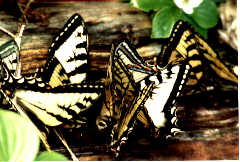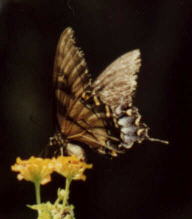Tiger Swallowtail
 The Tiger Swallowtail (Pterourus glaucus) belongs to the family Papilionidae, which is divided into two subfamilies: the Papilioninae (comprising Swallowtail butterflies) and Parnassiinae (comprising Parnassians). Less than 30 species of Papilionidae are found in North America.
The Tiger Swallowtail (Pterourus glaucus) belongs to the family Papilionidae, which is divided into two subfamilies: the Papilioninae (comprising Swallowtail butterflies) and Parnassiinae (comprising Parnassians). Less than 30 species of Papilionidae are found in North America.
The Tiger Swallowtail is one of the largest North American butterflies, with a wingspan of up to 5 ½ inches. It also has a most striking coloration - bright yellow with four black vertical tiger stripes, the innermost of which extends down to the hindwing; scalloped edges on the hindwings; and tails. It is very similar to the Western Tiger Swallowtail (Pterourus rutulus) and to the casual observer, they can only be distinguished by their range. The Tiger Swallowtail is found east of a roughly diagonal line which runs from the northwest corner of Montana to east Texas, while the Western Tiger is found to the west of the line, with some overlap in Montana, Wyoming and Colorado (and minimal overlap into the easternmost parts of South Dakota and Nebraska).
The Tiger Swallowtail is the official state butterfly of Georgia.
Life Cycle
 The adult female lays her eggs - yellow/green and globular - on a variety of trees and shrubs: willows and cottonwoods (Salicaceae), birches (Betulaceae), ashes (Fraxinus), cherries (Prunus) and tulip-poplars (Liriodendron tulipifera).
The adult female lays her eggs - yellow/green and globular - on a variety of trees and shrubs: willows and cottonwoods (Salicaceae), birches (Betulaceae), ashes (Fraxinus), cherries (Prunus) and tulip-poplars (Liriodendron tulipifera).
The caterpillar has two distinct forms at different stages. While the young caterpillar is brown and white, resembling bird droppings (an ingenious protection against being eaten by birds!) - the mature caterpillar, growing to about 2 inches, is green with a swollen front end, large eyespots on the head, and a black and white band between the 3rd and 4th segments. Using silk, the caterpillar curls leaves over its body and rests and feeds under a protective canopy.
Like all Swallowtail caterpillars, the Tiger Swallowtail has an osmeterium, a fleshy, forked organ behind the head which appears when the caterpillar is startled, emitting a foul-smelling odor which deters predators.
The chrysalis is either mottled green or brown and stick-like. It is slung by a silken girdle, head upright.
Puddling
 Male Tiger Swallowtails engage in an activity known as "puddling." They congregate in areas where water has accumulated and then evaporated, leaving a concentration of minerals, especially salt. The butterflies ingest these nutrients through their proboscis. The extra salt and other nutrients, such as amino acids, are passed on to the females during mating, and it is thought that they help with egg production. It is also believed that the nutrients help produce the male scent, pheromone, used in courtship to attract females.
Male Tiger Swallowtails engage in an activity known as "puddling." They congregate in areas where water has accumulated and then evaporated, leaving a concentration of minerals, especially salt. The butterflies ingest these nutrients through their proboscis. The extra salt and other nutrients, such as amino acids, are passed on to the females during mating, and it is thought that they help with egg production. It is also believed that the nutrients help produce the male scent, pheromone, used in courtship to attract females.
Above right: Tiger Swallowtails puddling.
Photo by Heather Ward, used with permission.
Dark form Females
 The female Tiger Swallowtail also exists in a dark form variation. The uppersides of the wings are blue/black, while the undersides are a sooty yellow imitation of the regular yellow butterfly. This dark form coloration resembles a Pipevine Swallowtail (Battus philenor) and is an example of a species seeking protection through mimicry. (Pipevine Swallowtails are toxic due to consumption of aristolochia sp. during the larval stage.) The more Pipevine Swallowtails in a particular area, the higher the concentration of dark form females in the corresponding Tiger Swallowtail population.
The female Tiger Swallowtail also exists in a dark form variation. The uppersides of the wings are blue/black, while the undersides are a sooty yellow imitation of the regular yellow butterfly. This dark form coloration resembles a Pipevine Swallowtail (Battus philenor) and is an example of a species seeking protection through mimicry. (Pipevine Swallowtails are toxic due to consumption of aristolochia sp. during the larval stage.) The more Pipevine Swallowtails in a particular area, the higher the concentration of dark form females in the corresponding Tiger Swallowtail population.
Classification of the Tiger Swallowtail
Kingdom - Animalia
Phylum - Arthropoda
Class - Insecta
Order - Lepidoptera
Superfamily - Papilionoidea
Family - Papilionidae
Subfamily - Papilioninae
Genus - Pterourus*
Species - Pterourus glaucus
*formerly assigned to the genus Papilio
Return to Home Page
 The Tiger Swallowtail (Pterourus glaucus) belongs to the family Papilionidae, which is divided into two subfamilies: the Papilioninae (comprising Swallowtail butterflies) and Parnassiinae (comprising Parnassians). Less than 30 species of Papilionidae are found in North America.
The Tiger Swallowtail (Pterourus glaucus) belongs to the family Papilionidae, which is divided into two subfamilies: the Papilioninae (comprising Swallowtail butterflies) and Parnassiinae (comprising Parnassians). Less than 30 species of Papilionidae are found in North America. The adult female lays her eggs - yellow/green and globular - on a variety of trees and shrubs: willows and cottonwoods (Salicaceae), birches (Betulaceae), ashes (Fraxinus), cherries (Prunus) and tulip-poplars (Liriodendron tulipifera).
The adult female lays her eggs - yellow/green and globular - on a variety of trees and shrubs: willows and cottonwoods (Salicaceae), birches (Betulaceae), ashes (Fraxinus), cherries (Prunus) and tulip-poplars (Liriodendron tulipifera). Male Tiger Swallowtails engage in an activity known as "puddling." They congregate in areas where water has accumulated and then evaporated, leaving a concentration of minerals, especially salt. The butterflies ingest these nutrients through their proboscis. The extra salt and other nutrients, such as amino acids, are passed on to the females during mating, and it is thought that they help with egg production. It is also believed that the nutrients help produce the male scent, pheromone, used in courtship to attract females.
Male Tiger Swallowtails engage in an activity known as "puddling." They congregate in areas where water has accumulated and then evaporated, leaving a concentration of minerals, especially salt. The butterflies ingest these nutrients through their proboscis. The extra salt and other nutrients, such as amino acids, are passed on to the females during mating, and it is thought that they help with egg production. It is also believed that the nutrients help produce the male scent, pheromone, used in courtship to attract females. The female Tiger Swallowtail also exists in a dark form variation. The uppersides of the wings are blue/black, while the undersides are a sooty yellow imitation of the regular yellow butterfly. This dark form coloration resembles a Pipevine Swallowtail (Battus philenor) and is an example of a species seeking protection through mimicry. (Pipevine Swallowtails are toxic due to consumption of aristolochia sp. during the larval stage.) The more Pipevine Swallowtails in a particular area, the higher the concentration of dark form females in the corresponding Tiger Swallowtail population.
The female Tiger Swallowtail also exists in a dark form variation. The uppersides of the wings are blue/black, while the undersides are a sooty yellow imitation of the regular yellow butterfly. This dark form coloration resembles a Pipevine Swallowtail (Battus philenor) and is an example of a species seeking protection through mimicry. (Pipevine Swallowtails are toxic due to consumption of aristolochia sp. during the larval stage.) The more Pipevine Swallowtails in a particular area, the higher the concentration of dark form females in the corresponding Tiger Swallowtail population.